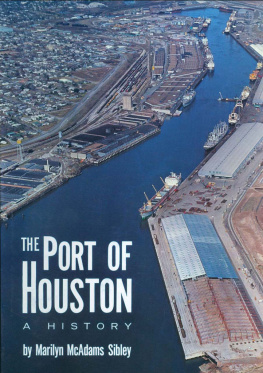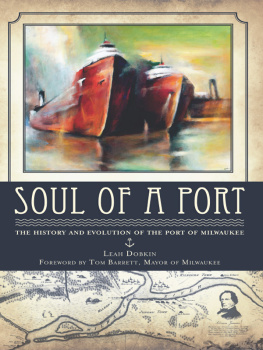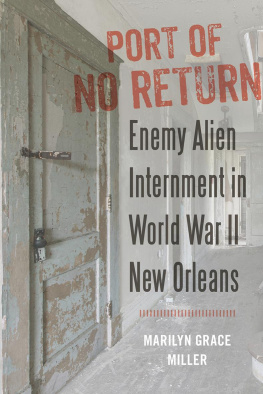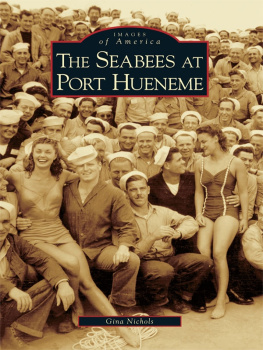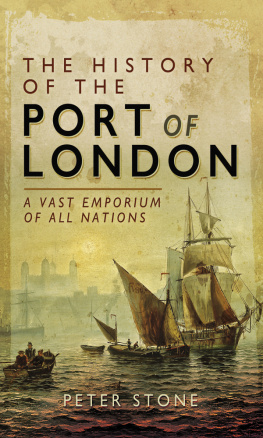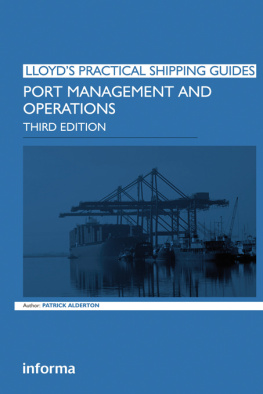Marilyn Mcadams Sibley - The Port of Houston: A History
Here you can read online Marilyn Mcadams Sibley - The Port of Houston: A History full text of the book (entire story) in english for free. Download pdf and epub, get meaning, cover and reviews about this ebook. year: 2011, publisher: University of Texas Press, genre: Home and family. Description of the work, (preface) as well as reviews are available. Best literature library LitArk.com created for fans of good reading and offers a wide selection of genres:
Romance novel
Science fiction
Adventure
Detective
Science
History
Home and family
Prose
Art
Politics
Computer
Non-fiction
Religion
Business
Children
Humor
Choose a favorite category and find really read worthwhile books. Enjoy immersion in the world of imagination, feel the emotions of the characters or learn something new for yourself, make an fascinating discovery.
- Book:The Port of Houston: A History
- Author:
- Publisher:University of Texas Press
- Genre:
- Year:2011
- Rating:3 / 5
- Favourites:Add to favourites
- Your mark:
- 60
- 1
- 2
- 3
- 4
- 5
The Port of Houston: A History: summary, description and annotation
We offer to read an annotation, description, summary or preface (depends on what the author of the book "The Port of Houston: A History" wrote himself). If you haven't found the necessary information about the book — write in the comments, we will try to find it.
The story of the growth of an unlikely inland port situated at a tent city that many Texans thought would die young.
The Port of Houston: A History — read online for free the complete book (whole text) full work
Below is the text of the book, divided by pages. System saving the place of the last page read, allows you to conveniently read the book "The Port of Houston: A History" online for free, without having to search again every time where you left off. Put a bookmark, and you can go to the page where you finished reading at any time.
Font size:
Interval:
Bookmark:

THE PORT OF HOUSTON
A HISTORY
Marilyn McAdams Sibley

UNIVERSITY OF TEXAS PRESS
AUSTIN
Library of Congress Catalog Card No. 6821251
Copyright 1968 by Marilyn McAdams Sibley
All Rights Reserved
ISBN 978-0-292-74812-5 (library e-book)
ISBN 978-0-292-78367-6 (individual e-book)
DOI 10.7560/736191

GITTINGS
DEDICATED TO
WILLIAM NEAL BLANTON
18901967
FOREWORD
The Board of Navigation and Canal Commissioners of the Port of Houston has long believed that a definitive history should be written to chronicle the growth of the Port and record its contribution to the development of the city. Consequently, shortly after the observance of Houstons fiftieth anniversary as a deep-water port in November of 1964, the Board, encouraged by the unflagging interest of the late Commissioner W. N. Blanton during his more than a dozen years of service, commissioned Dr. Marilyn McAdams Sibley to prepare such a history, which is respectfully dedicated to Commissioner Blantons memory.
This work is the result of Dr. Sibleys lengthy and exhaustive research, coupled with her own recognized ability as a narrator and historian. It presents for the first time the full and complete story of the nations third largest port from the days it was little more than a steamboat landing on a shallow and tortuous bayou, down to the immensity of its present operation.
To those men of vision who foresaw and worked for this great potential, to those men who served before us on this Port Commission, to those hundreds who have labored to build and operate this Port and to those who have assisted in the publication of this history, we are, indeed, grateful.
Howard T. Tellepsen, Chairman
R. H. Pruett, Commissioner
E. H. Henderson, Commissioner
W. D. Haden II, Commissioner
W. C. Wells, Commissioner
ACKNOWLEDGMENTS
Like the Port of Houston, this book is the work of many people. In a special way it is the work of the late William N. Blanton, who as Port commissioner for thirteen years was fascinated by the history of the Port and felt that it should be recorded. Over a period of years Mr. Blanton collected material, and, after the Port Commission arranged for the history to be written, he made his collection available as the foundation for this work.
Many others have also contributed material or drawn upon their memories to make this history as complete as possible, and to all of them I am indeed grateful. They will find many evidences of my indebtedness to them in the pages of the book.
For professional assistance I am especially indebted to Dr. James A. Tinsley, executive director of the Texas Gulf Coast Historical Association, under whose auspices this book was written; and to Dr. Andrew Forest Muir of Rice University, who made his extensive notes and knowledge of early Houston available and who read the manuscript.
ILLUSTRATIONS
Picture section
MAPS
I. A PORT FIFTY MILES FROM THE SEA
ON A SUMMER MORNING IN 1966 THE Sam Houston, inspection boat for the Port of Houston, took aboard some one hundred passengers for an excursion down the Houston Ship Channel. Twice and sometimes three times daily since 1958 the Sam Houston had made the cruise, showing to sightseers the wonders of Houstons manmade channel. From the Turning Basin, the head of deep water and the heart of Houstons waterfront, the channel stretched some fifty miles to meet the Gulf of Mexico at Bolivar Roads. For sixteen miles the channel followed the general course of historic Buffalo Bayou to its junction with the San Jacinto River, a point where General Sam Houstons army had won Texan independence in 1836. For nine additional miles the channel followed the San Jacinto River, cutting across Morgans Point to enter Galveston Bay, thence twenty-five miles across the open bay to Bolivar Roads and the Gulf. Even before it reached the Gulf the channel made significant connections. Near Galveston Island it connected with the Gulf Intracoastal Waterway, an inland barge system that served the Gulf Coast and connected with the Mississippi system. Farther up the bay it was linked by way of Clear Creek with the Manned Spacecraft Center of the National Aeronautics and Space Administration at Clear Lake; and by another tributary it served Bayport, an industrial park still in its early stages of development.
Although the ship channel followed the general course of natural streams, it was in fact a tribute to mans ingenuity and technical progress. The first generation of Anglo-American settlers in the area had dreamed of a channel that would bring ocean vessels across the shallow waters of Galveston Bay and inland to a point on meandering Buffalo Bayou. Later generations had inherited the dream, and late in the nineteenth century a group of practical dreamers had enlisted the assistance of the United States government. Throughout the twentieth century the United States Army Corps of Engineers had continually improved the waterway until it measured forty feet in depth for most of its length and from three to four hundred feet in width. In the same period first the City of Houston and then the Harris County Houston Ship Channel Navigation District had invested millions of dollars in Port facilities; and private interests had constructed industrial plants valued at an astronomical figure. Thus the waterway that the Sam Houstons passengers saw in 1966 bore little resemblance to that known to nineteenth-century Texans.
As the inspection boat turned downstream, a voice over the loudspeaker called attention to the Port facilities. Clustered around the Turning Basin were facilities owned by the Harris County Houston Ship Channel Navigation District, a governmental agency created under the statutes of the State of Texas and administered by a five-man Board of Navigation and Canal Commissioners. The Districts concrete wharves and warehouses lined the banks of the basin, and slightly downstream stood the public grain elevator, a facility constructed in the mid-1920s and enlarged time and again as Houston became one of the worlds leading grain ports. Somewhat farther downstream and on the south bank stood Long Reach Docks, for decades the largest private terminal on the channel but purchased by the Navigation District in late 1965. Across the stream from Long Reach were several wharves constructed by the District in the previous decade. Adjoining theseand speaking significantly of the dynamic growth of the Port of Houstonthe foundations for three additional wharves were being laid by workmen. By the 1960s these and other publicly owned Port facilitiesamong them, a bulk handling plant, a terminal railroad, and the World Trade Buildingwere yielding a profit of more than two million dollars annually.
As the Sam Houston moved downstream the voice over the speaker began pointing out the privately owned Port facilities. Four private terminals-for-hire supplemented the publicly owned facilities, and numerous private industrial wharves were scattered along the channel. In all, the Port had berthing space for almost a hundred ocean-going vessels and fifty barge docks. One hundred twenty steamship and ninety tanker lines made use of these facilities, transporting in 1965 almost sixty million tons of cargo valued at more than four billion dollars.
On both sides of the channel adjacent to the docks were large industrial plants that accounted for much of the Ports tonnage. Among these were cement factories using oyster shell from Gulf reefs; oil refineries supplied by pipelines and tankers; chemical plants feeding on petroleum by-products; steel mills utilizing scrap iron and foreign ore; and a paper mill fed by the forests of East Texas. Economists hesitated even to estimate the value of this industrial complex, but when pressed for a figure they hazarded a guess of three billion dollars.
Next pageFont size:
Interval:
Bookmark:
Similar books «The Port of Houston: A History»
Look at similar books to The Port of Houston: A History. We have selected literature similar in name and meaning in the hope of providing readers with more options to find new, interesting, not yet read works.
Discussion, reviews of the book The Port of Houston: A History and just readers' own opinions. Leave your comments, write what you think about the work, its meaning or the main characters. Specify what exactly you liked and what you didn't like, and why you think so.

